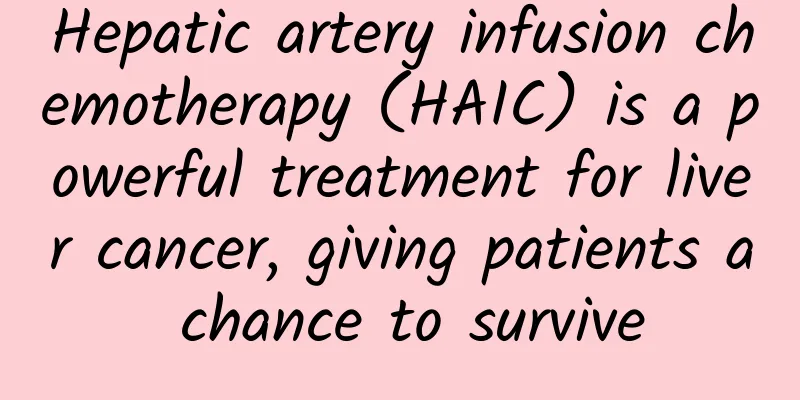Hepatic artery infusion chemotherapy (HAIC) is a powerful treatment for liver cancer, giving patients a chance to survive

|
Old Jiang is 61 years old this year and should have enjoyed his retirement life. Half a year ago, he felt a dull pain in his upper right abdomen and went to the hospital for a checkup. He unexpectedly found a mass of more than 10 centimeters in the liver with portal vein cancer thrombus. The alpha-fetoprotein reached more than 700, and he was diagnosed with primary liver cancer, BCLC stage C. The main lesion was massive and invasive, with unclear tumor boundaries. There was no chance of surgical resection at all, and several hospitals believed that the treatment effect would not be very good. Frightened and anxious, Lao Jiang came to the Interventional Department of Hunan Hospital of Integrated Traditional Chinese and Western Medicine (Affiliated Hospital of Hunan Institute of Traditional Chinese Medicine) to seek treatment with integrated Chinese and Western medicine. After receiving the patient, Director Li Wenquan of the Interventional Department fully assessed the patient's condition and, utilizing the hospital's advantage in combining traditional Chinese and Western medicine to treat tumors, recommended HAIC treatment first , followed by combined Chinese and Western medicine systemic anti-tumor treatment. After the treatment cycle, Lao Jiang's liver tumor was significantly reduced, the portal vein cancer thrombus retracted, abdominal distension was significantly relieved, and AFP dropped to normal values. Lao Jiang finally felt relieved and continued to use Chinese and Western medicine for treatment. He had regular checkups every 3-4 months. Lao Jiang was satisfied with the treatment results and regained his confidence and love for life. 1. What is HAIC treatment? Director Li Wenquan introduced that HAIC treatment , namely hepatic arterial infusion chemo-therapy (HAIC), is a minimally invasive interventional treatment method in which a catheter is inserted into the blood supply artery of the intrahepatic tumor via the femoral artery or radial artery to continuously infuse chemotherapy drugs, thereby increasing the drug concentration and duration of action in the liver tumor and thereby improving the anti-tumor effect. For patients with advanced liver cancer who cannot undergo surgical resection, HAIC, as an emerging interventional treatment method, brings new hope to patients. 2. What are the advantages of HAIC treatment? Is it complicated? Which patients is it suitable for? 1. Precisely attack tumors The drug acts directly on the tumor, with high local concentration and better efficacy. 2. Little side effects The drug mainly acts on the liver, has mild systemic side effects, and is better tolerated by patients. 3. Wide application range It is suitable for patients with advanced liver cancer who cannot be surgically removed, especially those with massive, diffuse, poor blood supply, or accompanied by portal vein tumor thrombosis, TACE resistance, insensitivity to systemic treatment, or resistance. 4. Can be combined with other treatments The model based on HAIC treatment combined with other systemic treatments has gradually matured. Diversified treatment strategies can make the most appropriate judgment for patients and further improve the efficacy. The treatment process of HAIC is not complicated, but it requires an interventional physician to accurately place the angiography catheter or microcatheter in the tumor-feeding artery of the liver through femoral or radial artery puncture under the guidance of DSA equipment. Individualized program design and drug selection (such as oxaliplatin, 5-FU, cisplatin, etc.), drug dosage and perfusion time need to be adjusted according to tumor type, stage, liver function, etc. 3. Efficacy and side effects of HAIC 1. Efficacy Studies have shown that the objective remission rate of HAIC-based combination therapy is significantly higher than that of traditional systemic chemotherapy and simple TACE treatment, which can effectively prolong the patient's survival and improve their quality of life. 2. Side effects Because the drug is concentrated in the liver tumor, the local concentration is high, the total dose is small, the local control rate is high, and the systemic toxicity and side effects are small and usually controllable. Patients who meet the treatment indications can generally tolerate it. Common side effects include abdominal pain, liver damage, cholangitis, gastrointestinal reactions, bone marrow suppression, etc. Most of them can be relieved or alleviated after symptomatic treatment. Rare complications include thrombosis, arterial injury, indwelling sheath infection, etc. 4. Key points and precautions for HAIC treatment 1. Key points Patient selection, catheter management, and liver function protection are the key to treatment. Benefits and risks must be fully assessed before treatment, and the treatment must be formulated by an experienced medical team and performed by experienced professional interventional physicians. 2. Notes Strict assessment of liver function and general condition is required before surgery; hepatic artery variation and complete tumor blood supply assessment are required during surgery; attention should be paid to catheter maintenance after surgery to prevent displacement, blockage, or infection; liver and kidney function, blood routine, and electrolytes should be monitored in a timely manner, be alert to drug-induced liver injury, and actively deal with possible adverse reactions. Experts advise The interventional team led by Director Li Wenquan reminded : From "being afraid of cancer" to "coexisting with cancer", early screening and early detection are needed to improve efficacy, delay progression, and prolong survival. For patients with advanced liver cancer, HAIC interventional treatment provides a new treatment option that can not only effectively prolong survival, but also increase surgical conversion rate, reduce tumor size, and improve quality of life. Hunan Medical Chat Special Author: Yang Jing and Mao Yuqi, Interventional Medicine Department, Hunan Hospital of Integrated Traditional Chinese and Western Medicine (Affiliated Hospital of Hunan Institute of Traditional Chinese Medicine) Follow @湖南医聊 to get more health science information! (Edited by YT) |
<<: What you thought was a cold might actually be leukemia! Don’t let these symptoms fool you
Recommend
Top 30 Chinese Game Companies and Apps with the Highest Overseas Revenue in February 2024
The ranking of Chinese game manufacturers and app...
Can I get pregnant if I ejaculate outside during ovulation?
We all know that the best way to successfully con...
What should I do if my milk increases after weaning?
Although breastfeeding has many benefits, it cann...
What should I do if I don’t know how to write an essay? How to write an essay outline
Many people are very confused and tormented when ...
Will cowhide shoes fade? What is split cowhide leather made of?
Cow leather is a kind of leather that is made fro...
How long after the follicle ruptures will you get pregnant?
After the ovary ruptures, you need to have sex as...
Will I get mastitis if I stop breastfeeding?
Women may have a variety of breast diseases, such...
What is the cause of breast pain during menstruation?
We know that breasts play a very important role f...
What are some tips for removing sun spots?
According to experts, combined with the web page ...
Causes of calf pain during pregnancy
Pregnant women have relatively low immunity, espe...
Does moxibustion affect menstruation?
For women, women without gynecological diseases h...
Let's talk about some basic knowledge about cardiac ultrasound
The heart, as one of the most important organs in...
What is the reason for less black menstrual discharge?
Every month when menstruating, women should learn...
How to feel out the cervical canal
When a pregnant woman is about to give birth, the...
How to discharge milk stasis by yourself
Generally speaking, there are two ways to raise a...









